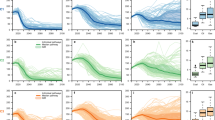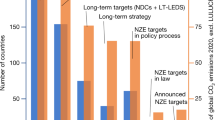Abstract
Parties to the 2015 Paris Agreement pledged to limit global warming to well below 2 °C and to pursue efforts to limit the temperature increase to 1.5 °C relative to pre-industrial times1. However, fossil fuels continue to dominate the global energy system and a sharp decline in their use must be realized to keep the temperature increase below 1.5 °C (refs. 2,3,4,5,6,7). Here we use a global energy systems model8 to assess the amount of fossil fuels that would need to be left in the ground, regionally and globally, to allow for a 50 per cent probability of limiting warming to 1.5 °C. By 2050, we find that nearly 60 per cent of oil and fossil methane gas, and 90 per cent of coal must remain unextracted to keep within a 1.5 °C carbon budget. This is a large increase in the unextractable estimates for a 2 °C carbon budget9, particularly for oil, for which an additional 25 per cent of reserves must remain unextracted. Furthermore, we estimate that oil and gas production must decline globally by 3 per cent each year until 2050. This implies that most regions must reach peak production now or during the next decade, rendering many operational and planned fossil fuel projects unviable. We probably present an underestimate of the production changes required, because a greater than 50 per cent probability of limiting warming to 1.5 °C requires more carbon to stay in the ground and because of uncertainties around the timely deployment of negative emission technologies at scale.
This is a preview of subscription content, access via your institution
Access options
Access Nature and 54 other Nature Portfolio journals
Get Nature+, our best-value online-access subscription
$32.99 / 30 days
cancel any time
Subscribe to this journal
Receive 51 print issues and online access
$199.00 per year
only $3.90 per issue
Buy this article
- Purchase on SpringerLink
- Instant access to full article PDF
Prices may be subject to local taxes which are calculated during checkout


Similar content being viewed by others
Data availability
The results data and key source data in the figures (including in the Supplementary Information) are available via Zenodo at https://doi.org/10.5281/zenodo.5118971. Source data are provided with this paper.
Code availability
The underlying code (mathematical equations) for the model is available via GitHub (https://github.com/etsap-TIMES/TIMES_model). The full model database is also available via Zenodo (https://doi.org/10.5281/zenodo.5118971). Given the complexity of the model, further guidance will be provided on model assumptions upon reasonable request from the corresponding author.
Change history
25 January 2022
A Correction to this paper has been published: https://doi.org/10.1038/s41586-021-04334-0
References
Adoption of the Paris Agreement https://unfccc.int/resource/docs/2015/cop21/eng/l09r01.pdf (United Nations, 2015).
The Production Gap Report: 2020 Special Report http://productiongap.org/2020report (SEI, IISD, ODI, E3G & UNEP, 2020).
Rogelj, J. et al. in Special Report on Global Warming of 1.5 °C (eds Masson-Delmotte, V. et al.) (IPCC, WMO, 2018).
Luderer, G. et al. Residual fossil CO2 emissions in 1.5–2 °C pathways. Nat. Clim. Change 8, 626–633 (2018).
Grubler, A. et al. A low energy demand scenario for meeting the 1.5 °C target and sustainable development goals without negative emission technologies. Nat. Energy 3, 515–527 (2018).
Tong, D. et al. Committed emissions from existing energy infrastructure jeopardize 1.5 °C climate target. Nature 572, 373–377 (2019).
Anderson, K. & Peters, G. The trouble with negative emissions. Science 354, 182–183 (2016).
Pye, S. et al. An equitable redistribution of unburnable carbon. Nat. Commun. 11, 3968 (2020).
McGlade, C. & Ekins, P. The geographical distribution of fossil fuels unused when limiting global warming to 2 °C. Nature 517, 187–190 (2015).
Masson-Delmotte, V. et al. (eds) Special Report on Global Warming of 1.5 °C (IPCC, WMO, 2018).
Rogelj, J. et al. Scenarios towards limiting global mean temperature increase below 1.5 °C. Nat. Clim. Change 8, 325–332 (2018).
World Energy Outlook 2019 (IEA, 2019).
BP Energy Outlook: 2020 Edition https://www.bp.com/content/dam/bp/business-sites/en/global/corporate/pdfs/energy-economics/energy-outlook/bp-energy-outlook-2020.pdf (BP, 2020).
Unburnable Carbon 2013: Wasted Capital and Stranded Assets (Carbon Tracker & Grantham Research Institute of Climate Change and the Environment, 2013).
Lau, W. W. Y. et al. Evaluating scenarios toward zero plastic pollution. Science 369, 1455–1461 (2020).
The Future’s Not in Plastics: Why Plastics Demand Won’t Rescue the Oil Sector https://carbontracker.org/reports/the-futures-not-in-plastics/ (Carbon Tracker Initiative, 2020).
Godoi, J. M. A. & dos Santos Matai, P. H. L. Enhanced oil recovery with carbon dioxide geosequestration: first steps at Pre-salt in Brazil. J. Petrol. Explor. Prod. 11, 1429–1441 (2021).
Beyond Petrostates: The Burning Need to Cut Oil Dependence in the Energy Transition https://carbontracker.org/reports/petrostates-energy-transition-report/ (Carbon Tracker Initiative, 2021).
Green, F. & Denniss, R. Cutting with both arms of the scissors: the economic and political case for restrictive supply-side climate policies. Clim. Change 150, 73–87 (2018).
Erickson, P., Lazarus, M. & Piggot, G. Limiting fossil fuel production as the next big step in climate policy. Nat. Clim. Change 8, 1037–1043 (2018).
Lazarus, M. & van Asselt, H. Fossil fuel supply and climate policy: exploring the road less taken. Clim. Change 150, 1–13 (2018).
Newell, P. & Simms, A. Towards a fossil fuel non-proliferation treaty. Clim. Policy 20, 1043–1054 (2020).
Piggot, G., Erickson, P., van Asselt, H. & Lazarus, M. Swimming upstream: addressing fossil fuel supply under the UNFCCC. Clim. Policy 18, 1189–1202 (2018).
World Energy Outlook 2020 (IEA, 2020).
Decline and Fall: The Size & Vulnerability of the Fossil Fuel System https://carbontracker.org/reports/decline-and-fall/ (Carbon Tracker Initiative, 2020).
Muttitt, G. & Kartha, S. Equity, climate justice and fossil fuel extraction: principles for a managed phase out. Clim. Policy 20, 1024–1042 (2020).
Petroleum Resources Management System http://info.specommunications.org/rs/833-LLT-087/images/PRMgmtSystem_V1.01Nov27.pdf?mkt_tok=ODMzLUxMVC0wODcAAAF9dSrG2UNYnY2eBC7yyN17I25FkaA9i2XvL5kjWdgP6mXak-NSn63rWtB1NFtduvqTfPhyTxIcU92WlXrHa762rjvWID3PytxB3BUUJLfhomzKAA (Society of Petroleum Engineers, 2018).
McCollum, D. L. et al. Interaction of consumer preferences and climate policies in the global transition to low-carbon vehicles. Nat. Energy 3, 664–673 (2018).
Marangoni, G. et al. Sensitivity of projected long-term CO2 emissions across the Shared Socioeconomic Pathways. Nat. Clim. Change 7, 113–117 (2017).
Erickson, P. et al. Why fossil fuel producer subsidies matter. Nature 578, E1–E4 (2020).
McGlade, C. Uncertainties in the Outlook for Oil and Gas. PhD thesis, UCL (2013).
Biomass in a Low-Carbon Economy https://www.theccc.org.uk/publication/biomass-in-a-low-carbon-economy/ (CCC, 2018).
Huppmann, D., Rogelj, J., Kriegler, E., Krey, V. & Riahi, K. A new scenario resource for integrated 1.5 °C research. Nat. Clim. Change 8, 1027–1030 (2018).
Fuss, S. et al. Negative emissions—part 2: costs, potentials and side effects. Environ. Res. Lett. 13, 063002 (2018).
Creutzig, F. et al. Bioenergy and climate change mitigation: an assessment. Glob. Change Biol. Bioenergy 7, 916–944 (2015).
Integrated Assessment of Global Environmental Change with IMAGE 3.0: Model Description and Policy Applications https://www.pbl.nl/en/publications/integrated-assessment-of-global-environmental-change-with-IMAGE-3.0 (PBL, 2014).
Fricko, O. et al. The marker quantification of the Shared Socioeconomic Pathway 2: a middle-of-the-road scenario for the 21st century. Glob. Environ. Change 42, 251–267 (2017).
Bauer, N. et al. Global energy sector emission reductions and bioenergy use: overview of the bioenergy demand phase of the EMF-33 model comparison. Clim. Change 163, 1553–1568 (2020).
Fuss, S. et al. Betting on negative emissions. Nat. Clim. Change 4, 850–853 (2014).
Gautier, D. & Moore, T. in The 2008 Circum-Arctic Resource Appraisal Professional Paper No. 1824 (eds Gautier, D. & Moore, T.) (USGS, 2017).
BGR Energy Study 2019: Data and Developments Concerning German and Global Energy Supplies https://www.bgr.bund.de/EN/Themen/Energie/Downloads/energiestudie_2019_en.pdf;jsessionid=A73E36C969C2253E194ADF4E2484C95A.1_cid321?__blob=publicationFile&v=6 (BGR, 2020).
Assumptions to the Annual Energy Outlook 2020: Oil and Gas Supply Module https://www.eia.gov/outlooks/aeo/assumptions/pdf/oilgas.pdf (EIA, 2020).
Laherrère, J. Future of oil supplies. Energy Explor. Exploit. 21, 227–267 (2003).
OPEC Annual Statistical Bulletin 2019 https://www.opec.org/opec_web/static_files_project/media/downloads/publications/ASB_2019.pdf (OPEC, 2019).
Statistical Review of World Energy https://www.bp.com/content/dam/bp/business-sites/en/global/corporate/pdfs/energy-economics/statistical-review/bp-stats-review-2020-full-report.pdf (BP, 2020).
Energy Study 2016: Reserves, Resources and Availability of Energy Resources (BGR, 2016).
Russian Energy 2015 https://ac.gov.ru/files/publication/a/10205.pdf (Analytical Centre for the Government of the Russian Federation, 2016).
Natural Gas Information 2019 https://www.iea.org/reports/natural-gas-information-2019 (2019).
Acknowledgements
We thank P. Erickson (SEI), G. Muttitt (IISD) and C. McGlade (IEA) for commenting on a draft version of this paper. This work has been supported by the European Climate Foundation (ECF) and the UK Energy Research Centre Phase 4 (grant numberEP/S029575/1).
Author information
Authors and Affiliations
Contributions
All authors were involved in the design approach to the research. D.W. and J.P. undertook the scenario modelling and analysed the results. All authors contributed to the development of early drafts of the paper, and to writing the final paper.
Corresponding author
Ethics declarations
Competing interests
The authors declare no competing interests.
Additional information
Peer review information Nature thanks Dieter Franke, Gang He and Michael Lazarus for their contribution to the peer review of this work. Peer reviewer reports are available.
Publisher’s note Springer Nature remains neutral with regard to jurisdictional claims in published maps and institutional affiliations.
Extended data figures and tables
Extended Data Fig. 1 Supply cost curves split by region in TIAM-UCL.
a–c, Curves for oil (a), fossil methane gas (b) and coal (c). Costs are given on an energy-content basis (barrel of oil equivalent for oil, British thermal units for gas and joules for coal), on a US$2005 basis. For oil, different mining processes output different commodities (for example, oil sands mining initially (pre-upgrading) outputs a barrel of bitumen) hence the use of the energy-content cost basis. For gas, associated gas is not included in Extended Data Fig. 1b as it is a by-product of oil production
Supplementary information
Supplementary Information
This file contains supplementary text, supplementary table 1 – 26, supplementary equations, supplementary figures 1 – 17 and supplementary references.
Rights and permissions
About this article
Cite this article
Welsby, D., Price, J., Pye, S. et al. Unextractable fossil fuels in a 1.5 °C world. Nature 597, 230–234 (2021). https://doi.org/10.1038/s41586-021-03821-8
Received:
Accepted:
Published:
Issue Date:
DOI: https://doi.org/10.1038/s41586-021-03821-8
This article is cited by
-
Layered Na2Ti3O7-supported Ru catalyst for ambient CO2 methanation
Nature Communications (2025)
-
The global implications of a Russian gas pivot to Asia
Nature Communications (2025)
-
Quantifying the shift of public export finance from fossil fuels to renewable energy
Nature Communications (2025)
-
Carbon offsetting of fossil fuel emissions through afforestation is limited by financial viability and spatial requirements
Communications Earth & Environment (2025)
-
Prospecting urban mines of fossil fuel-based energy systems in the energy transition
Communications Earth & Environment (2025)



